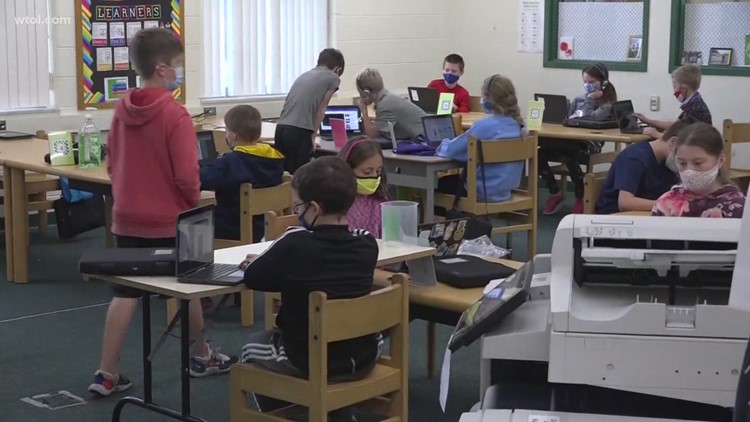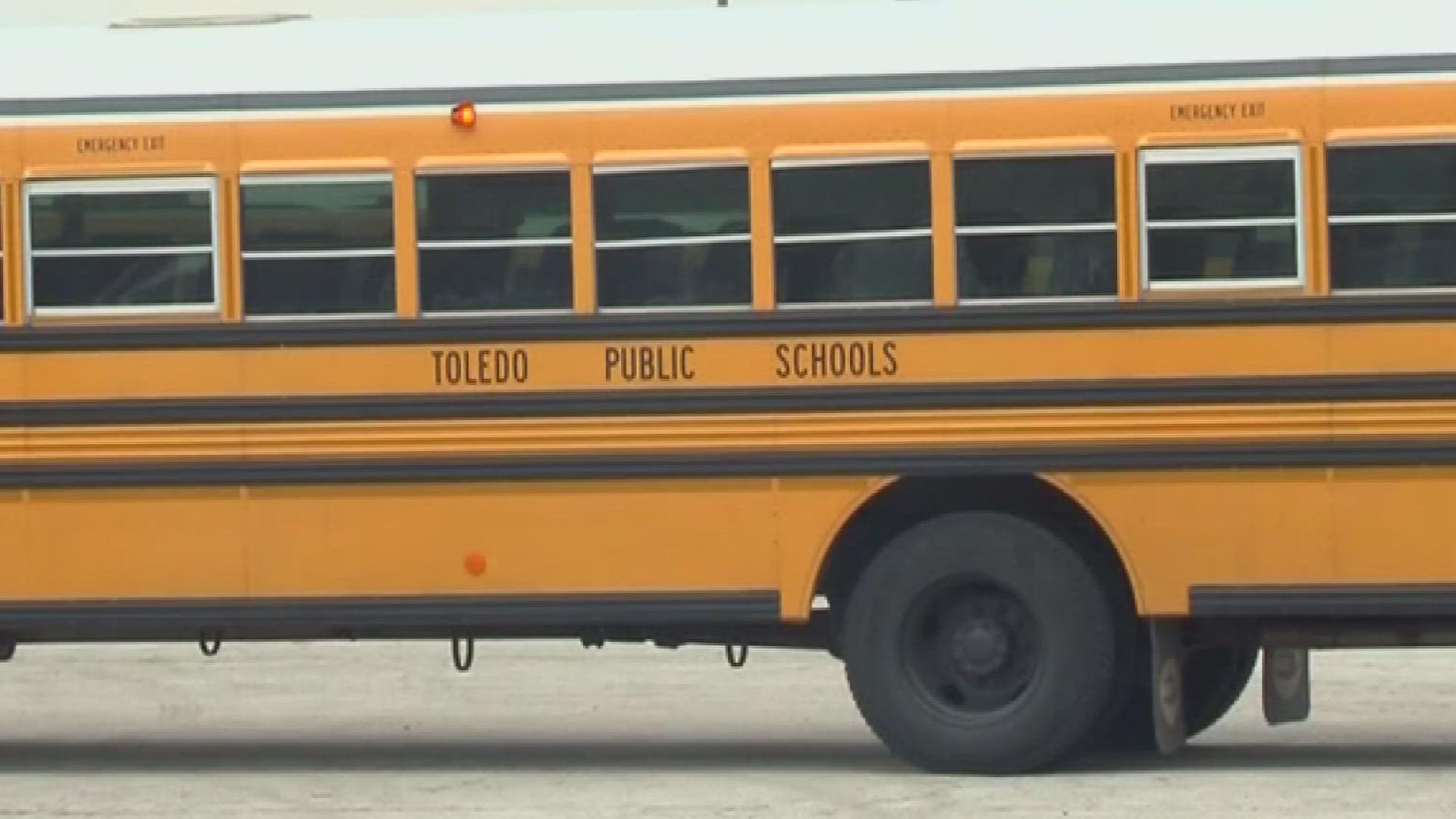COLUMBUS, Ohio — Ohio teachers and school staff qualified to get their shots on Feb. 1, but only if their district agreed to get back in the classroom, in some capacity, by March 1.
Ohio Gov. Mike DeWine has repeatedly pushed for kids to return to in-person learning, including it in his top three goals for the state's vaccination plan. In a number of his weekly briefings, the governor claimed while some students are fine in a remote learning environment, others struggle immensely.
2020 ENROLLMENT DATA
According to the 2020 fall enrollment and assessment data, at the beginning of the school year, there was a decrease in enrollment by about 3%, with a high concentration being in pre-school and kindergarten age groups.
Student performance scores were also lower. In kindergarten, 8% more students were found to be "not on track." For the state's third-graders, about 8% less students scored "proficient" or better. Almost all districts, 87%, had a decrease in this same metric between 2019 and 2020.
YOUTH MENTAL HEALTH
However, state leaders say performance is not the only concern. According to Ohio’s Director of Mental Health and Addiction Services Lori Criss, in communities across the state, youth have been presenting with more acute mental health symptoms during the pandemic.
"School is community for kids. It benefits them beyond their academic content; it's the social and emotional connections that kids feel with friends, classmates, extracurriculars, teachers and more," Criss said.
Criss explained that remote learning is taking its toll on some students.
The Centers for Disease Control and Prevention (CDC) has recognized that beyond getting sick, many young people's social, emotional and mental well-being has been impacted by the coronavirus.
Criss said that when kids aren’t in school, the change of routine and constant uncertainty often produces anxiety. Disconnection from learning, emotional, and social supports can lead to depression. Missed significant life events – like proms and sports competitions - can also result in grief.
You should reach out for help if a young person in your life is:
- Talking about feeling hopeless
- Worrying about being a burden
- Feeling like there's no reason to live
- Using drugs or alcohol or engaging in other risky behaviors
- Struggling with school
- Disconnecting from family and friends
CDC RECOMMENDATIONS
But is going back to school safe? According to the CDC, there is strong evidence now that in-person schooling can be done safely, especially at lower grade levels, and new guidance released from the agency last week is targeted at schools that teach kindergarten up to grade 12.
Here are some key things this guidance emphasized:
- Mask-wearing
- Social distancing
- Hand washing
- Disinfection of school facilities
- Diagnostic testing
- Contact tracing
CDC officials said that in-person learning has not been identified as a major source of coronavirus spread. However, health leaders also stressed that the safest way to open schools is by making sure there are low levels of the disease in a community.
Local officials have been encouraged to assess whether a major outbreak is occurring in their communities when making school decisions. CDC guidance includes a color-coded chart on assessing community spread, including rates of new cases per 100,000 people and the positivity rate in the area.
OHIO FEDERATION OF TEACHERS
From the beginning, DeWine has gotten a bit of pushback from teacher’s unions.
The Ohio Federation of Teachers, for example, sent a letter to the governor saying, in part, the governor was "holding this precious commodity hostage while pitting parents, administrators, teachers, other school workers, and students against each other."
A spokesperson with DeWine's office said the main purpose of the requirement is to make sure kids have all the benefits of in-person instruction.
"In order to most efficiently use the limited vaccine available, the governor made the decision to offer the vaccine to the adults who work in schools whose districts have indicated that they will go back to in-person learning. The decision to go back is up to the districts," the spokesperson wrote.
One of the groups that signed on to the joint statement was the Toledo Federation of Teachers (TFT).
DEWINE ADDRESSES SCHOOLS THAT WON'T RETURN BY MARCH 1
All public school districts in the state besides one signed the governor's letter of intent to return to in-person learning, or at least a hybrid model, by March 1 in order to get the vaccine.
However, DeWine said last week that at least three districts announced plans that indicated they would not be making the state's deadline, despite already receiving the vaccine. Those districts were Cincinnati Public Schools, Akron Public Schools and Cleveland Public Schools.
Cincinnati Public Schools was notably the first district to receive the vaccine and did so before educators technically qualified. According to DeWine, the district's superintendent had requested her schools receive the vaccine early.
Vaccination has long been complete within the district, but DeWine claimed Friday that one of its high schools, Walnut Hills, is expected to stay remote the rest of the academic year.
A reporter noted during one of DeWine's briefings that the district made that decision after they realized that proper distancing within the building would not be possible, but DeWine said that issue should have been raised much sooner, when the letter of intent had been signed.
Akron City Schools also completed the vaccination of its staff, but district leaders have since reported that they do not plan to return to in-person learning until March 15 - two weeks after the state's deadline.
Cleveland City Schools was in the middle of vaccinating its staff, although DeWine said he had heard "different reports" over whether or not Cleveland would go back by March 1.
The governor detailed a discussion he had with the district's CEO Eric S. Gordon, saying he asked if the state should "stop the vaccination." DeWine said that at the end of that call, Gordon promised to do everything in his power to get kids back by that March 1 date.
The optics of that conversation aren’t great for the governor, especially after he’s already been accused of using the vaccine as a bargaining chip by the Ohio Federation of Teachers. However, the governor said that suggestion was not meant to be seen as some sort of punishment. Instead, if those finite doses weren’t going to be used for what they were meant to be used for, which is getting kids back in school, they could instead be reallocated to Ohio’s most vulnerable citizens.
Since last week’s press conference, it has come to light that another northeast Ohio district may not make that March 1 date either. Youngstown City Schools is set to announce its plan next week, and it looks unlikely they will get back on the governor’s timeline. However, DeWine made clear, that despite them falling short of that deadline, everyone who has been vaccinated will be able to get their second dose.
Right now, it doesn’t look like any districts will face any sort of punitive measures for not making their return.
RELATED VIDEO
HOW MANY SCHOOLS ARE BACK TO IN-PERSON LEARNING?
DeWine said that in Dec., 45% of Ohio’s students were at a school that was fully remote, that number has since dropped to 15%.
Locally, here's a look at what the Big 11 districts have in store.
ANTHONY WAYNE
- Feb. 22: K-6 return fully in-person
- Feb. 22: 7-12 continue on hybrid schedule
BEDFORD
- Feb. 1: All grade levels return fully in-person, with remote option available
BOWLING GREEN
- Feb. 23: All grades on a hybrid model
FINDLAY
- Feb. 22: All grades on four-day in-person learning model
MAUMEE
- Jan. 11: All grades fully in-person
OREGON
- Feb. 19: K-6 fully in-person
- March 15: 7-12 four day in-person learning
- April 6: All grades fully in-person
PERRYSBURG
- March 1: Elementary fully in-person
- March 1: Jr. High four-day in-person learning
- March 16: High school four-day in-person learning
- March 30: Pre-school four-day hybrid model
SPRINGFIELD
- Jan. 19: All grades on hybrid model
SYLVANIA
- March 22: Fully in-person
TOLEDO PUBLIC SCHOOLS
- Feb. 22: Pre-K - 3 on hybrid model
- Feb. 25: 4 - 8 on hybrid model
- March 1: All students on hybrid model
WASHINGTON LOCAL
- Feb. 1: All students on hybrid model
NATIONAL EFFORT
The push to get kids back learning in-person is also coming in at a federal level. President Joe Biden has promised to get at least K-8 students back into the classroom, five days per week by the end of his first 100 days in office.
But, the president has been caught between competing interests as he works to get these students back to in-person education without upsetting the powerful teacher's unions that helped get him elected, which claim schools in some areas have failed to make buildings safe enough to return.
Biden's 100th day in office is April 30, 2021.



